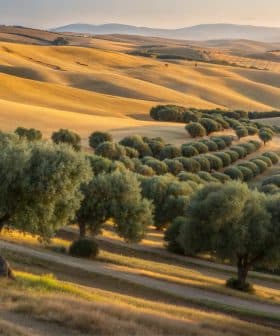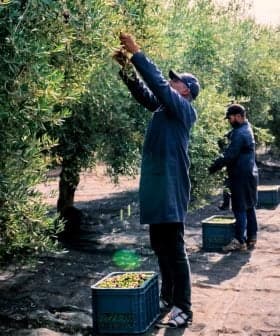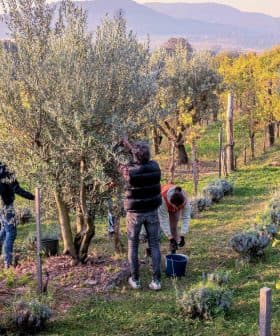Study Shows Mineral Clay Applications Boost Olive Oil Production
A study in Greece assessed the use of mineral clays to mitigate the effects of climate change on olive cultivation, finding that the application of talc, kaolin, and attapulgite increased oil yield and quality under different conditions. The researchers suggest further research to tailor the technique to local conditions and cultivars, as well as government support to help the olive industry adapt to climate change.
A new study, the first of its kind to be published in the field of olive cultivation, has assessed the efficacy of mineral clay applications in mitigating the increasingly prolonged and extreme summers associated with climate change in the Mediterranean olive-growing regions.
Previous research has shown such treatments to be beneficial against certain pest insects, but none have examined their effects on oil yield or quality.
The study, published in the journal Horticulturae, reports the results of field experiments conducted in Lakonia, Greece, during the 2021 cultivation season.
See Also:Carbon-Capturing Power of Olive Groves MeasuredKoroneiki, the most common olive cultivar used for oil production in Greece, was chosen, and trees under both rain-fed and irrigated conditions were studied.
Before the trial, preliminary experiments were conducted in Crete and Sterea Ellada prefectures using the Megaritiki cultivar, in addition to Koroneiki.
The trees studied were selected based on uniform growth and similar expected yields, and were free from visible symptoms of nutrient deficiencies, pest infestations, or disease infections.
All trees were 30 years old, open-vase trained, and planted in a 7‑meter by 7‑meter grid, managed following standard local practices (fertilization, pruning, pesticide application, etc.), which were applied uniformly to all trees.
During the trial period, the maximum temperatures in July, August, and September were 40 °C, 43 °C, and 36 °C, respectively.
In recent years, several Mediterranean countries have experienced drastic reductions in their olive oil production, with yields as low as 50 percent of the standard.
Despite olive trees’ natural resilience, extreme heat, high solar irradiation and prolonged drought, especially during flowering and fruit development, can have a significant impact on tree health and productivity.
Trees from both groups were sprayed with mineral clays using particle film technology in either July or August.
The clays utilized were kaolin, talc and attapulgite. Kaolin clay has previously been trialed in the protection of pomegranate fruit from extreme heat and solar irradiation in southern Spain with some success.
Under irrigated conditions, the application of talc increased oil production per tree by approximately 22 percent, kaolin by 17 percent and attapulgite by five percent compared to untreated trees.
In rain-fed conditions, where trees face greater environmental stresses, talc applied in July resulted in the highest increase in oil yield, at 80 percent. Attapulgite, applied in August, increased oil production by 57 percent, while kaolin, applied in July, increased it by more than 50 percent. These gains were attributed to the clays’ reflective and water-conserving properties, which help maintain leaf hydration and reduce canopy temperature.
In addition to yield, oil quality was analyzed. Ultraviolet absorbance indices, such as K232 and K270, which reflect primary and secondary oxidation, improved with all three clay treatments, particularly talc and kaolin.
Talc and kaolin also increased phenolic content under both irrigation conditions, though the effects were negligible under irrigated conditions, with the sole exception of tyrosol. Tyrosol concentration was significantly affected, being higher in oils from trees treated with talc in July.
This aligns with previous research highlighting the role of heat and water stress in stimulating the synthesis of antioxidant compounds in olive trees. Under rain-fed conditions, the concentrations of nearly all detected phenolic compounds (oleocanthal, oleacein, tyrosol, luteolin and apigenin) were significantly influenced by the treatments.
Analysis of fatty acid composition revealed that oils from treated trees had a higher proportion of oleic acid and monounsaturated fatty acids, particularly under rain-fed conditions.
The authors note that lower canopy temperatures may preserve enzymatic activities involved in oil biosynthesis, mitigating the conversion of oleic to linoleic acid under heat stress. This has previously been hypothesized to account for differences in oil composition between warm and cool climates.
Climatic stresses affect every stage of olive development, from bud differentiation and flowering to fruit growth and ripening.
Reduced chilling hours can disrupt floral bud development, while extreme summer heat may lower oil content and alter fatty acid profiles.
The authors note that by increasing the trees’ resilience to harsh summer conditions, the following year’s production is also positively affected due to improved floral induction, fruit development and new shoot growth.
While concluding that clay particle application is an effective tool, the authors caution that multiple factors influence the degree of improvement achieved.
These factors include, among others, the timing of application, soil conditions and management practices, such as irrigation.
They believe that further research is needed to tailor the technique to the local conditions and cultivars of target regions, and to integrate such treatments with other measures that could enhance resilience.
“I believe the next steps should be the combined application of mineral clays with other alleviating products with different mode[s] of action,” lead author Petros Roussos told the Olive Oil Times.
“Furthermore, further research is needed to find the exact time and which mineral clay fits better under certain conditions in each cultivar, since we saw that different cultivars respond differently to these clay materials while irrigated groves [also respond differently] to rainfed ones,” he added.
Roussos also believes that while independent research is vital, governments can do more to address climate threats to the olive industry.
“There are many ways to help the industry adapt to climate change,” he said. “First of all, education and information [about] what the industry can do – easy, cheap, affordable and effective methods – to adopt them.”
“Then take measures on specific aims,” Roussos concluded. “This means funding specific areas of research, such as the evaluation of indigenous olive cultivars under climate change scenarios, adapting cultural methods to alleviate stress impacts, etc.”









